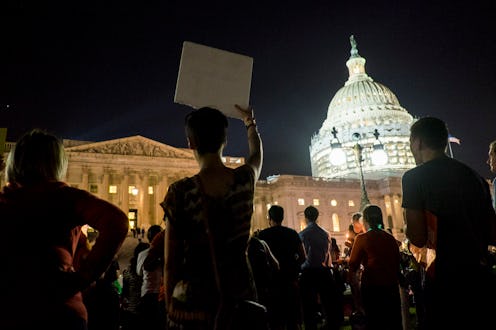News
Scott Peters Is The House Periscope Hero
Even though most people outside of Southern California and Washington, D.C. have probably never heard of him, Rep. Scott Peters is the Democrats' sit-in hero for their House of Representatives protest over gun control reform. He's the man who helped launch the Periscope broadcast of the sit-in and educated his Congressional colleagues: "There’s an app called Periscope, and I understand that if too many people watch it that it crashes, so if other people had it or wanted to download it, maybe they’d like to try it out too and it would generate a little more capacity for the effort.”
Thanks to Peters, many more people got to watch the sit-in, and as it continues into its second day, on thing is clear: this event is exciting government TV — a contradiction-in-terms any other day of the week.
If you were a civics nerd like me as a kid and relished learning about the Constitution, then you probably can relate to the disappointment at turning on C-SPAN only to discover how dry and dreary the actual everyday coverage of government could be. That all changed yesterday, when Democrats, led by Civil Rights leader Rep. John Lewis, stormed the floor of the lower house, chanting “No bill, no break!” and singing “We shall overcome.” It looked less like the House of Representatives and more like the House of Commons, complete with shouting matches and banging gavels.
That seemed to all come to an end when Republican leaders forced the House into recess, which, according to chamber rules, also cut the camera feed to C-SPAN. That’s when Rep. Peters started broadcasting using his smartphone via Periscope.
Shortly after he began broadcasting, C-SPAN picked up the feed and has been broadcasting the sit-in ever since. This isn’t the first time that C-SPAN has been used for political ends — Newt Gingrich famously exploited the newly-born cable network in 1979 for his own ends. In 2008, when then House Speaker Nancy Pelosi refused to schedule a vote on offshore drilling, Republicans also protested with a sit-in, but C-SPAN couldn't broadcast it then, as well. According to Politico, Pelosi and Democrats also cut off power then, too.
But the House rules were written at a time before everyone with a smartphone began carrying around a video broadcasting device in their pocket, and Rep. Peters seized on the moment, taking a decades-old protest move (civil disobedience) and giving it a 21st Century boost.
In an era where the ubiquity of video is playing such a crucial role in transparency, we’re becoming accustomed to events that would normally go undocumented coming to stark light via cell phones. When all the dust settles after this sit-in has ended, one thing will remain clear: Rep. Peters will have changed the way we think about viewing our government — literally and technologically.
